
Nov . 01, 2024 07:24 Back to list
Understanding Hydroxyethyl Cellulose CAS Number and Its Applications in Various Industries
Hydroxyethyl Cellulose An Overview
Hydroxyethyl cellulose (HEC) is a widely used water-soluble polymer derived from cellulose, a natural polymer found in the cell walls of plants. With the Chemical Abstracts Service (CAS) number 9004-62-0, HEC has garnered attention in various industries due to its unique properties and versatility.
Chemical Structure and Properties
HEC is formed by the substitution of hydroxyethyl groups for the hydroxyl groups in cellulose. This modification enhances the solubility of the polymer in water, making it an effective thickening and film-forming agent. HEC appears as a white, odorless powder that is non-ionic, making it compatible with a vast range of substances. It is pH-stable and does not gel, which is beneficial for maintaining the consistency of products across various pH levels.
One of the most notable features of HEC is its rheological properties. It can significantly increase the viscosity of aqueous solutions, making it an excellent thickener, stabilizer, and emulsifier. The viscosity of HEC solutions can be adjusted by altering the concentration of the polymer, which allows formulators to tailor product consistency based on specific requirements.
Applications of Hydroxyethyl Cellulose
hydroxyethyl cellulose cas no

HEC finds applications across various sectors, including cosmetics, pharmaceuticals, food, and construction. In the cosmetic industry, it is often used in shampoos, conditioners, lotions, and creams to improve texture and provide a smooth application. Its ability to form films makes it beneficial in products aimed at providing water resistance.
In pharmaceuticals, HEC serves as a binder, thickener, and stabilizer in creams, gels, and ointments, ensuring that active ingredients are effectively delivered and retained. It also plays a role in controlled-release formulations, helping to moderate the release of medication over time.
The food industry utilizes HEC as a thickening and stabilizing agent in products like sauces, dressings, and dairy items. It helps to achieve the desired texture without compromising flavor, making it an essential ingredient in many food formulations.
Additionally, HEC is used in construction materials, particularly in cement and mortar, where it enhances workability and water retention. It helps to improve the overall performance of the materials, ensuring a smoother application and a more resilient final product.
Conclusion
Hydroxyethyl cellulose is a versatile and valuable polymer with a broad range of applications across different industries. Its unique properties, including thickening capabilities, compatibility with various substances, and stability across different pH levels, make it a preferred choice for formulators. As industries continue to seek innovative solutions, the demand for HEC is likely to grow, reinforcing its position as a critical ingredient in modern formulations.
-
Versatile Hpmc Uses in Different Industries
NewsJun.19,2025
-
Redispersible Powder's Role in Enhancing Durability of Construction Products
NewsJun.19,2025
-
Hydroxyethyl Cellulose Applications Driving Green Industrial Processes
NewsJun.19,2025
-
Exploring Different Redispersible Polymer Powder
NewsJun.19,2025
-
Choosing the Right Mortar Bonding Agent
NewsJun.19,2025
-
Applications and Significance of China Hpmc in Modern Industries
NewsJun.19,2025







